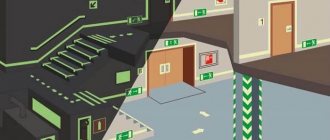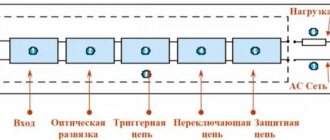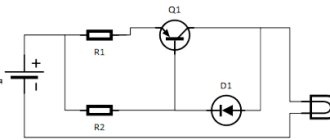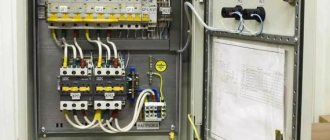Home » Electrical installation » Electrical panels » Types of electrical panels
People who often come across different electrical panels have noticed that they have a wide range. To understand which electrical panel is best to choose, you need to know what the letter codes that are indicated on its box mean. In this article we tried to consider the types of electrical panels.
Mounting panel
We tried to consider only popular equipment, as well as the goals and objectives that each individual type of electrical panel performs.
Floor board (SHE)
This is the most common type of device, which every apartment resident is familiar with. Specialists install such panels in almost all residential multi-storey buildings on each site. In the future, these devices will be responsible for supplying electricity to the apartment, and will also be able to protect all household appliances from power surges.
SHE
Typically, floor panels will consist of the following parts:
- A subscriber camera in which protective fuses will be installed.
- Recording cameras. Counters will be installed in it.
- Low current chamber. It is intended for wired Internet and cable television devices.
Apartment board (SchK)
Such designs can most often be used in apartments. They allow you to replace floor panels. Its purpose is practically no different from floor panels, but there are a couple of exceptions.
ShchK
With the help of an apartment switchboard, you can turn off the power in your apartment at almost any time. Also, with its help, in the future you will be able to turn off the electricity in any room of your house. Secondly, power meters are rarely installed in such structures. Sometimes such a problem can cause a lot of litigation between you and the company that services your home.
Lighting board (SHB)
Based on the name today, we can conclude that these devices are intended for control of lighting devices. Most often, such devices can be used in non-residential buildings that are large. Examples include shopping centers and food hypermarkets. The principle of operation of a lighting board is similar to that of a regular switch.
SCHO
As with any other type of equipment, you can install fuses here, as well as power meters. The most common model at the moment is considered to be a recessed lighting panel with a switch (UOSCHV). If necessary, its box can be easily mounted into a wall and disguised with finishing materials.
Electrical diagram of the distribution board
It is developed based on the purpose of the ShchR and the specifics of use. The schemes differ in complexity, layout, and number of modules. But the principle of their construction is the same.
- Availability of an input switch (switch, AB).
- Mandatory protection of secondary circuits from overloads and short circuits.
- Eliminating the risk of electric shock to the user (differential circuit breakers, RCDs).
Requirements of governing documents
It is useless to list them in detail - the average user is not able to remember everything stated in the regulatory documentation regarding switchboards. When developing a circuit, choosing a control unit, and installing it, the following recommendations should be taken into account:
- PUE (7th edition, section 4);
- GOST;
- SNiPov;
- SP (set of rules 9.131.30 of 2009);
- RD.
All requirements are advisory in nature, as stated in the letter of the Federal Supervisory Service dated May 27, 2011. Various documents place emphasis on ensuring protection:
- health, human life;
- property of any form of ownership;
- environment, flora, fauna.
Purchasing, assembling a distribution board, installing, connecting - in these matters you cannot do without consulting a professional. When working with electrical devices, amateur activity is unacceptable and very dangerous.
The choice of distribution board is made taking into account many factors: installation method, purpose, layout, the size of the gap between the back wall of the box and the DIN rail, and a number of others. Contact us, we have ShchR of all types and sizes in stock. We will help you understand the assortment, select the optimal version of the product, and offer an electrical distribution board for any assembled circuit.
Control panel (control panel)
This type of electrical panels is installed at manufacturing enterprises. Unlike other shields, such structures can have a rather complex structure and design. Today they can be used for various purposes.
control room
Depending on the purpose, such shields do not have a specific standard size. As a rule, such cabinets can be of impressive size with a large number of switches inside.
Types of power shields
Depending on the installation location, power panels for installation outside or inside premises. For external installation, the housing has appropriate protection against the penetration of moisture, dust, etc. It can have several degrees, which determine the place where the shield can be installed. The most common degrees of protection are:
- IP20, IP30. They are not protected from moisture, so they can only be installed indoors under normal humidity conditions. Protected only from mechanical impact.
- IP44, IP54. In addition to increased protection from foreign objects, they have protection from moisture. Allowed for installation in rooms with high humidity. When installed outside, they should be located out of direct water jets.
- IP55, IP65. The most protected shields that can be used indoors and outdoors even in aggressive environments. IP55 is partially dustproof, and IP65 is fully dustproof.
Power boards by installation method
Depending on the installation method, the panels are:
- Mounted, or overhead. Mounted directly on a wall or other building structure. The entire body is located outside the base on which it is located.
- Built-in. They are mounted in a niche - a recess specially prepared in the wall. Only the lid remains visible from the outside, and the entire body is recessed into the wall.
- Floor-standing. The housing is placed on the floor covering or on a special stand on the floor.
By purpose
The configuration of distribution boards may include various electrical devices, protective and control elements. It all depends on the purpose of the equipment. It also determines what the price of the power shield . Its intended uses are as follows:
- ASU – water distribution device. Receive electrical energy from power supply lines or power transformers.
- Main distribution board - main distribution board. The same ASU, only it receives and distributes electricity inside buildings or apartments.
- Group shield. Controls individual groups of current consumers: household appliances, lamps, plug sockets, etc. Equipped with protection devices (circuit breakers) and switching. Analogues are apartment and floor distribution boards.,
Automation panel (ASB)
This device will be responsible for monitoring complex systems. All elements here will be managed automatically.
Automation mounting panel
The automation panel can be equipped with many sensors and controllers that will monitor various indicators. Based on these indicators, the device can independently turn off and turn on individual systems. The device can be used for a variety of tasks. In this case, in each individual case, various models of shields can be used. For example, if you use a boiler for a boiler, it can also be used for a ventilation system.
Use in furniture production
In carpentry, panels can be used to make structures out of wood. They are also widely used in the production of interior items. From furniture board you can make:
- tables and chairs;
- chests of drawers;
- shoe racks in the hallway;
- stools;
- children's and adult beds.
Variety of handles for kitchen furniture, the best manufacturers
Sometimes wooden panels are used to replace plasterboard when finishing walls and ceilings. Door panels and various types of stairs made from this material are very popular. Furniture boards laid as parquet boards look beautiful.
Most often, cabinet furniture in living rooms and hallways is made from maple panels; alder and linden are less popular. The uniqueness of the first material is that it can be used to decorate any type of premises. Due to their increased resistance to moisture and mechanical external influences, products made from sheets of different sizes are well suited for children's rooms, bathrooms and toilets. A variety of colors and shades, as well as patterns on the surface, makes it easy to choose the wood that is most suitable for a specific interior. The products go well with Provence and classic styles, but poorly with hi-tech.
Tables, chairs, stools
Dressers
Shoe racks in the hallway
Beds
Wall decoration
As parquet
Emergency input of backup power (ABP)
This electrical panel is capable of providing emergency power in the event of a main system failure. This type of device can be considered the most common, and it is used in almost every electrical network. If electricity suddenly stops flowing into the system, then the AVR will automatically switch it to the emergency power source.
AVR
Most often, two subtypes of AVR shields can be used:
- Priority shield. There is only one power channel here.
- Non-priority shield. Any power source can be the main one.
You need to choose a specific product depending on personal preferences, as well as the characteristics of the electrical network.
A short course on the history of medieval shields
During excavations of a series of Scythian burials, the remains of shields with a metal coating were discovered. Despite the fragility of this element, which is part of the defensive weapons complex, it was given quite a lot of importance. Shields collected and decorated with precious metals and gems were considered very expensive gifts; they were presented to the most noble warriors.
As we will see below, the main material for the production of shields was: - Wood covered with leather; — Sometimes bronze plates were used; — Early shields used metal umbos and metal strips to reinforce the shield and nails. — a thin chalk primer was placed on top, onto which emblems with inscriptions were applied using tempera paint. Occasionally, metal shields were encountered. As V. Beheim points out, the first shields of medieval society, for example, among the Germans, were very simple. In general, they were similar to the shields used in the Roman legions, but with a quadrangular shape they were less curved. Made from willow twigs, they were covered with fur, usually from wolves. Fur-covered shields were used until the 13th century. From this custom comes the “heraldic fur” in the Middle Ages.
Shields in the time of Charlemagne were mostly made of wood, covered with leather and reinforced with iron strips. The rider had a light, wooden, round or pointed shield with iron stripes on nails. In the center of the round shield was attached a bulge - an umbon (German: Schildnabel). They wore a shield on the left hand, with a wide belt into which the hand was threaded.
The foot warrior wore a large, almond-shaped, more than a meter high, strongly curved wooden shield, which was reinforced at the edges and in the middle with crossed iron strips studded with strong nails.
The Norman shield was made of wood with a chalk primer, narrow, pointed at the bottom and rounded at the top, and can be considered as a prototype of the entire later form of medieval shields.
Shields of the 11th and 12th centuries were of considerable length. Concern for the strength of the shield led to the fact that it was made very convex and equipped with iron plates. XIII century: The shield became more and more flat, the umbons and overlays gradually disappeared. Standing shield, or large paveza. These shields were made of wood and covered with leather; a thin chalk primer was applied on top, onto which emblems with inscriptions were applied with tempera paint.
Already in the 11th century, horsemen sought to free their left hand from holding the shield so that they could control the horse. This led to the fact that the tarch began to be hung around the neck. and the chest was completely closed. This kind of tarch, although there are some made of iron, was mostly made of wood and covered with leather; they are quadrangular in shape, with rounded corners, and have a sharply protruding rib in the middle.
The old Moorish adagra was made of strong, tough leather, oval, in the shape of a heart or two cut ovals. Adarga, in the 13th and 14th centuries, came from the Moors to the Spanish troops and further to France, Italy and even to England, where it remained in use until the 15th century. The old Moorish adagra was made of strong, tough leather, oval, in the shape of a heart or two cut ovals. They wore it on a belt over the right shoulder, and on the left they held it by the fist handle. These excellent shields were made in Fez and were used until the end of the 17th century by cavalrymen armed with lances in Oran, Melil, Ceuta and further along the coast of Granada. Their images can be seen on the frescoes of the Alhambra.
Light Arab cavalrymen, and from them the wars of the border lands of the Polish-Lithuanian Commonwealth, used small round shields, called kalkan in Turkish, with a top made of fish skin, which was either left rough or polished smooth. Such shields were often made of leather with beautiful embossed patterns. Finally, there were shields made of thin fig tree twigs, which were shaped in a circle, concentrically, and intertwined with silver braid or colored silk threads in such a way as to form arabesques, executed with great taste. These kind of round shields with a diameter of no more than 60 cm had extraordinary resistance to a blow from a sword.
Fencing shield (German: Fechtschild), which was common in fencing schools. These very long and narrow shields were made of wood, covered with leather and painted. In the middle of such a shield there was a high rib, hollow inside, and along it there was an iron reinforcing rod. Long iron points with or without irreversible hooks protruded from the top and bottom of the shield. The total length of the shield was 2.5 meters.
In more recent times, shields become more complex and are integrated with various devices. The wooden board served as the main material from which medieval shields were made. The shield was covered with leather. Depending on the era, certain parts were added to the shield: umbons, radial steel strips to strengthen the shield, edging. I would also like to note that edging in medieval shields, such as tarch, was used extremely rarely.
Two circumstances led to the improvement of the weapons of the peoples who settled in Europe. Firstly, the relationship they entered into with Constantinople, where they received weapons at a trade crossroads, and secondly, the fact that in their raids on Rome they came into contact with countries in which iron had long been mined and weapons made. Those South Germanic peoples who were in contact with the Roman Empire at the beginning of imperial times necessarily adapted to the Roman way of warfare. From here arise first, borrowed from the Romans, and then purely Germanic, corresponding to national characteristics, forms of weapons.
And I would like to separately note that the shield is elliptical in shape, as a separate special type of shield of the early Middle Ages. Perhaps it was precisely such shields that were the primary sources of almond-shaped (drop-shaped) shields.
The Norman shield became a new milestone and the fundamental basis for the development of most shields of the Middle Ages. Norman shields of the 11th and 12th centuries were of considerable length, since it was necessary to protect the rider from impact weapons from the legs to the shoulders. They were no different for horsemen and infantry. The infantry stand in dense rows so that their long shields, overlapping each other, form a solid wall that protects from arrows. It was at this time that armor improved significantly. This significant result, learned from the experience of the Crusades, was the reason that during the 13th century the cavalry shield gradually became shorter. It now covered the rider from hip to chin. The side edges remained strongly curved, but the upper edge was made more and more horizontal, because previously it served to protect the face, but now, thanks to the new helmets, this was not so necessary. The shield became more and more flat, the umbons and overlays gradually disappeared.
It is curious that infantry shields before the 13th and even until the 14th centuries differed very little from cavalry shields. The reason for this is that the infantry was given little importance in the war and therefore it was not considered necessary to think about its special needs. This is how the infantryman used the cavalry shield, although in its shape it was designed for protection while riding. On foot, the triangular shield clearly did not cover the person enough. Only when the cavalry shield was so reduced that it became completely unusable for infantry was the difference in armament felt. The infantry retained the old long almond-shaped shields, which the cavalry abandoned.
From about 1300, the technical improvement of armor again made significant progress, and the cavalry shield became even less important. It becomes a small triangular tarch (German: Tartsche) with straight edges, which more or less covered half the chest and left shoulder. The name “tarch” comes from the Arabic “darake”, from which the Italian “targa” is derived, as the small rounded shield was initially called. Towards the end of the 14th and 15th centuries, the form of tarchs underwent changes, but rather not of a military-technical, but of a stylistic nature. They become semicircular from below, sometimes, as in England and Northern France, quadrangular, almost square.
Since the 14th century, the desire to use the power of the infantry and equip it accordingly has become increasingly noticeable. These aspirations led again to the most ancient infantry defensive formations, which were used with great success by the Romans and were often used in the early Middle Ages in Germany. The technique consisted of creating a solid wall of shields placed tightly one to the other, behind which the warriors took cover and could use their ancient weapons. For such purposes, a new type of shield has appeared, originating from the tarch shield - a standing shield (German Setzschild), or a large pavese (German große Pavese).
The shape of these pavezas is generally a quadrangle. In the center there is a vertical groove, hollow inside, which ends at the upper end with a protrusion protruding forward (Fig. 183). Leather carrying straps were attached inside, below which there was a handle. In some foot detachments of the German army at the beginning of the 15th century, instead of paveuses [139], they used the best protective, but difficult to transport, assault walls or assault shields (German: Sturmwande), which have been preserved to this day in the Maritime Museum. Often such shields had a viewing slit or eye hole at the top and were equipped with iron spikes at the bottom. If the large paveza was an effective weapon in defense, then there was inevitably a desire to provide the same effective protection to the attacking infantryman. Therefore, a manual pavese arises (German: Handschild, kleine Pavese). It is mostly quadrangular, tapering downward and has a characteristic groove, the corners of which are sometimes rounded. The oldest of these shields have a groove with sharpened edges.
Already in the 11th century, horsemen sought to free their left hand from holding the shield so that they could control the horse. This led to the fact that the tarch began to be hung around the neck and the chest was completely closed. This kind of tarch, although there are some made of iron, was mostly made of wood and covered with leather; they are quadrangular in shape, with rounded corners, and have a sharply protruding rib in the middle. In order not to interfere with the rider's use of the spear, they had a deep recess on the right, into which the spear shaft was placed.
A special type of tarch was used in Hungary in the 15th century. These are trapezoidal shields, convex, so that they are pressed to the chest and cover the left side of the body. These tarchs found use not only in Hungary, but also in other countries that were to one degree or another under the influence of the East: in Poland and Muscovy. Apparently, such cavalry shields were also worn by the horsemen of King Mateusz Corvinus (1440-1490) and the Hungarian guard of Maximilian I. Some examples of such tarchs are still preserved in the Imperial collections of Vienna. Where the Hungarians came into contact with the Germans, there was a tendency to combine the advantages of the German shields with the Eastern ones. Here the Tarchi keep a notch on the right side for the shaft of a spear. But in the middle of the 15th century, “Hungarian tarchs” began to be produced everywhere in Germany.
Bucklers are small, round fist shields that are an optional defensive weapon for the infantryman. As a rule, a steel umbon was riveted to the field of the shield. Bucklers were either completely metal or with a wooden field (again, made from boards or from one wide board). The wooden edge of the buckler was upholstered with steel or leather. The usual diameter of a buckler is from 20 to 32 cm. It is primarily an infantry archer's or billman's shield, although esquires and knights also sometimes used it. The main function is protection and fencing against the sword, both civil and optional combat protection (along with the sword).
Slavic warriors long before the emergence of Kievan Rus, according to Byzantine authors of the 6th century. it is shields that act as the only means of protection: Procopius of Caesarea: “When entering battle, the majority go to the enemies on foot, having small shields and spears in their hands, but they never put on armor.” Mauritius Strategist: "Each man is armed with two small spears, and some of them with shields, strong, but difficult to carry." Unfortunately, it is not possible to imagine the appearance of the above-mentioned Slavic shields, since there is no pictorial or archaeological evidence from written sources. Obviously, Slavic shields of this time were made entirely from organic materials (boards, rods) and, due to the lack of metal parts, have not survived to this day. The earliest fragments of shields found on the territory of Ancient Rus' date back to the 10th century. With rare exceptions, these are only metal parts. Thus, information for recreating the appearance and design features of the shields is very limited. On the territory of Ancient Rus', fragments of at least 20 shields have been archaeologically recorded. The most common and clearly identifiable part of the shield is the umbon, which is an iron hemisphere attached to the center of the shield. A.N. Kirpichnikov distinguishes two types of Old Russian umbos: hemispherical and spheroconic. 13 out of 16 found specimens belong to the first type. All of them are standard in shape - a hemispherical vault on a low neck, and in size - diameter 13.2-15.5 cm, height 5.5-7 cm. The metal thickness does not exceed 1.5 mm. The second type includes three umbons, two of which come from the South-Eastern Ladoga region and another one was found in the Old Russian layer of the Tsimlyansky settlement. These are umbos of a spheroconic shape, most clearly expressed in the Ladoga specimens. They are slightly larger than the umbons of the first type: diameter 15.6 cm and 17.5 cm, height 7.8 cm and 8.5 cm. There is no neck. The umbon from the Tsimlyansky settlement is distinguished by its smaller size (diameter 13.4 cm, height 5.5 cm) and the presence of a small protrusion at the top of the arch. The umbos of both types have fields 1.5-2.5 cm wide. On these fields, from 4 to 8 holes were punched through which nails (rarely rivets) passed, securing the umbo to the wooden field of the shield. Several fastening nails have been preserved, which make it possible to approximately calculate the thickness of the wooden field under the umbon. With a length of 2.5 to 5 cm, the nails are bent in such a way that the thickness of the wooden field is reconstructed within 7-8 mm. At the same time, on one of the umbos of the second type found in the Ladoga region, a rivet was recorded that did not have bends, 4.5 cm long. According to A.N. Kirpichnikov, such rivets simultaneously fastened the edge of the umbo, the shield board and the handle bar. In addition to the umbons, the identifiable part of the shield are the metal fittings attached to the edge of the shield. In six cases, the bindings were found together with umbos, in three - without umbos. The number of fetters ranged from a few pieces to two dozen. They are thin (0.5 mm) iron (in one case, bronze) strips about 6 cm long and about 2 cm wide, bent in half. On one of the bindings there are traces of ornamentation in the form of two parallel lines. The bindings were fastened to the edge of the shield with two small rivets. Most Old Russian bindings had a step on both sides, which, as foreign material shows, was necessary for the placement of a leather strip running along the edge of the shield. The distance between the edges of the frame in all cases was 5-6 mm, which was equal to the thickness of the wooden field at the edge of the shield.
During pre-revolutionary excavations at the Gnezdovo burial mound near Smolensk, well-preserved remains of a shield were found. This is how the author of the excavations describes it: “Thanks to the traces of wood remaining from the shield, one can imagine approximately the dimensions of the shield by measuring the distance of these pieces of wood from the central plaque or umbon; with this measurement, the width or length of the shield reaches 1 meter. In the area of the shield that once lay, many iron clips or clips were found [meaning edge bindings - S.K.] in the form of iron plates bent in half with holes or nails at the ends, which served to fasten the edges of the shield and perfectly preserved pieces of wood inside; These pieces of wood often represent oblique layers, which are clearly explained by the fact that the boards of which the shield consisted had curves at the edges corresponding to the circumference of the circle. Taking into account the preserved traces of wood on nearby stones, we can also safely say that the shield had a circular outline. The thickness of the panel boards can also be easily determined by the iron clips; It can also be considered to some extent probable that the shield was painted red, since the wood in one of the frames retained traces of red paint.” This is practically all that ancient Russian archeology gives for recreating the shield. Summarizing the above, we can say that that part of the Old Russian shields, which is recorded by archaeological sources, had a round field 5-8 mm thick, sometimes equipped with a metal umbon and, less often, metal fittings along the edge.
Input switchgear (IDU)
This type of electrical panels is also quite popular. In most cases, ASUs can be installed in residential premises, as well as production workshops. The shield allows you to receive and distribute electricity through small power channels. In a typical multi-story building, these panels are usually installed on the first floor or in the basement.
Where to install ASU










